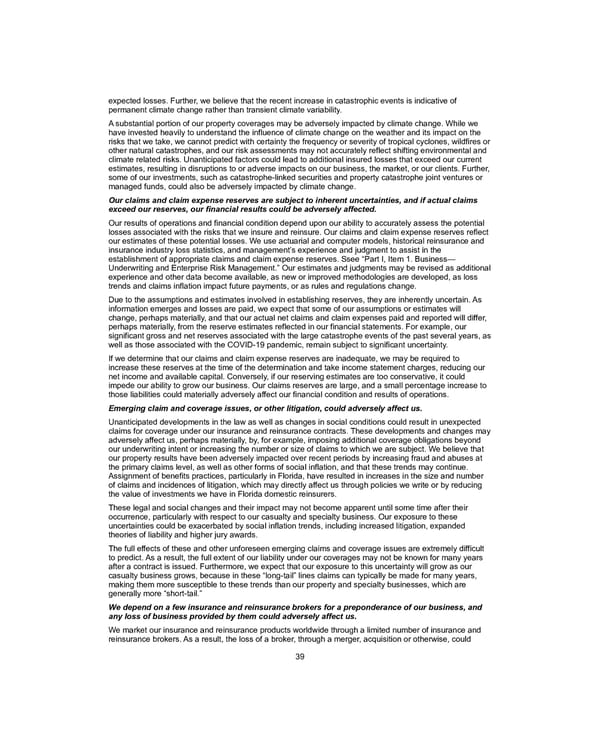expected losses. Further, we believe that the recent increase in catastrophic events is indicative of permanent climate change rather than transient climate variability . A substantial portion of our property coverages may be adversely impacted by climate change. While we have invested heavily to understand the influence of climate change on the weather and its impact on the risks that we take, we cannot predict with certainty the frequency or severity of tropical cyclones, wildfires or other natural catastrophes, and our risk assessments may not accurately reflect shifting environmental and climate related risks. Unanticipated factors could lead to additional insured losses that exceed our current estimates, resulting in disruptions to or adverse impacts on our business, the market, or our clients. Further, some of our investments, such as catastrophe-linked securities and property catastrophe joint ventures or managed funds, could also be adversely impacted by climate change. Our claims and claim expense reserves are subject to inherent uncertainties, and if actual claims exceed our reserves, our financial results could be adversely affected. Our results of operations and financial condition depend upon our ability to accurately assess the potential losses associated with the risks that we insure and reinsure. Our claims and claim expense reserves reflect our estimates of these potential losses. We use actuarial and computer models, historical reinsurance and insurance industry loss statistics, and management’s experience and judgment to assist in the establishment of appropriate claims and claim expense reserves. Ssee “Part I, Item 1. Business— Underwriting and Enterprise Risk Management.” Our estimates and judgments may be revised as additional experience and other data become available, as new or improved methodologies are developed, as loss trends and claims inflation impact future payments, or as rules and regulations change. Due to the assumptions and estimates involved in establishing reserves, they are inherently uncertain. As information emerges and losses are paid, we expect that some of our assumptions or estimates will change, perhaps materially, and that our actual net claims and claim expenses paid and reported will differ, perhaps materially, from the reserve estimates reflected in our financial statements. For example, our significant gross and net reserves associated with the large catastrophe events of the past several years, as well as those associated with the COVID-19 pandemic, remain subject to significant uncertainty. If we determine that our claims and claim expense reserves are inadequate, we may be required to increase these reserves at the time of the determination and take income statement charges, reducing our net income and available capital. Conversely, if our reserving estimates are too conservative, it could impede our ability to grow our business. Our claims reserves are large, and a small percentage increase to those liabilities could materially adversely affect our financial condition and results of operations. Emerging claim and coverage issues, or other litigation, could adversely affect us. Unanticipated developments in the law as well as changes in social conditions could result in unexpected claims for coverage under our insurance and reinsurance contracts. These developments and changes may adversely affect us, perhaps materially, by, for example, imposing additional coverage obligations beyond our underwriting intent or increasing the number or size of claims to which we are subject. We believe that our property results have been adversely impacted over recent periods by increasing fraud and abuses at the primary claims level, as well as other forms of social inflation, and that these trends may continue. Assignment of benefits practices, particularly in Florida, have resulted in increases in the size and number of claims and incidences of litigation, which may directly affect us through policies we write or by reducing the value of investments we have in Florida domestic reinsurers. These legal and social changes and their impact may not become apparent until some time after their occurrence, particularly with respect to our casualty and specialty business. Our exposure to these uncertainties could be exacerbated by social inflation trends, including increased litigation, expanded theories of liability and higher jury awards. The full effects of these and other unforeseen emerging claims and coverage issues are extremely difficult to predict. As a result, the full extent of our liability under our coverages may not be known for many years after a contract is issued. Furthermore, we expect that our exposure to this uncertainty will grow as our casualty business grows, because in these “long-tail” lines claims can typically be made for many years, making them more susceptible to these trends than our property and specialty businesses, which are generally more “short-tail.” We depend on a few insurance and reinsurance brokers for a preponderance of our business, and any loss of business provided by them could adversely affect us. We market our insurance and reinsurance products worldwide through a limited number of insurance and reinsurance brokers. As a result, the loss of a broker, through a merger, acquisition or otherwise, could 39
 2021 Annual Report Page 54 Page 56
2021 Annual Report Page 54 Page 56